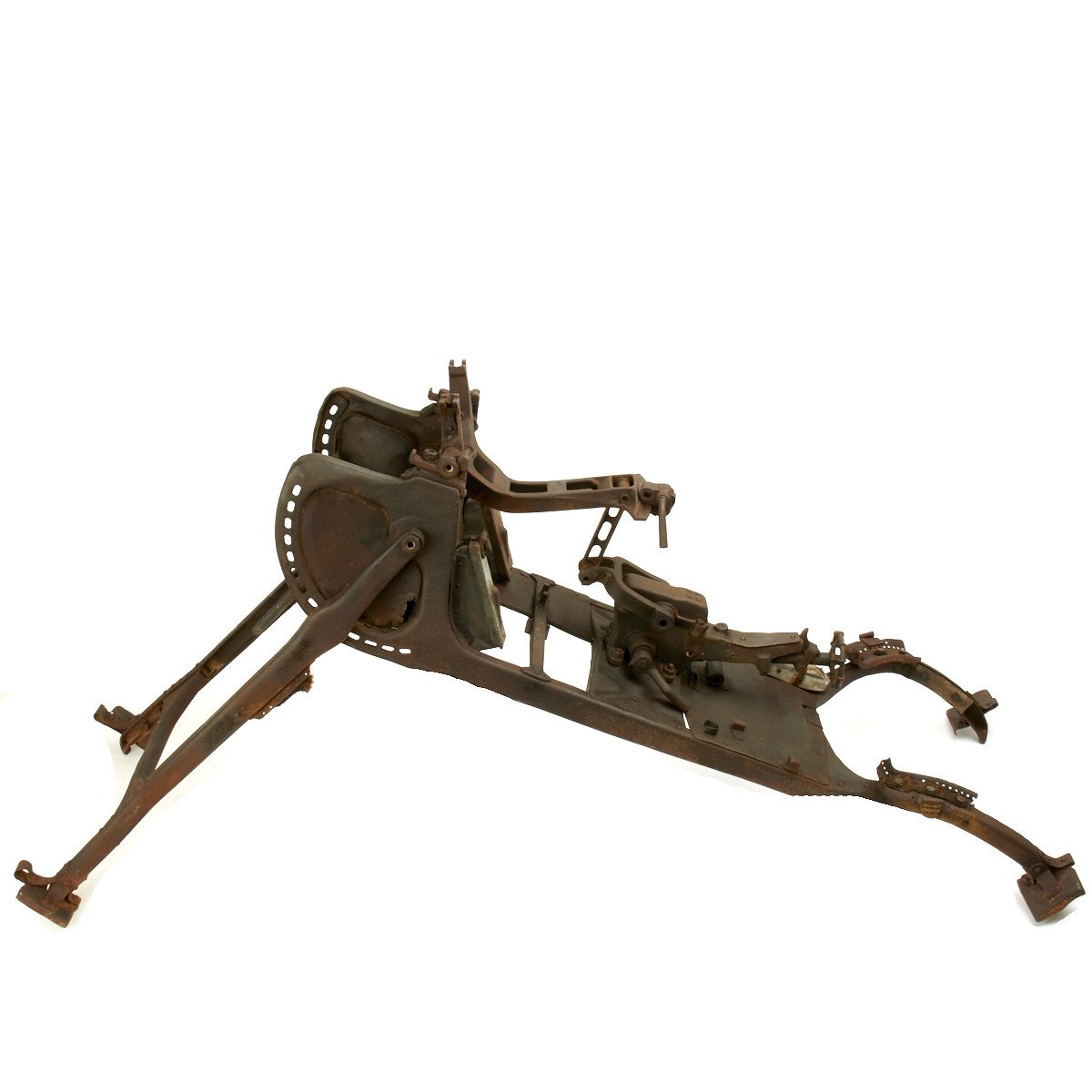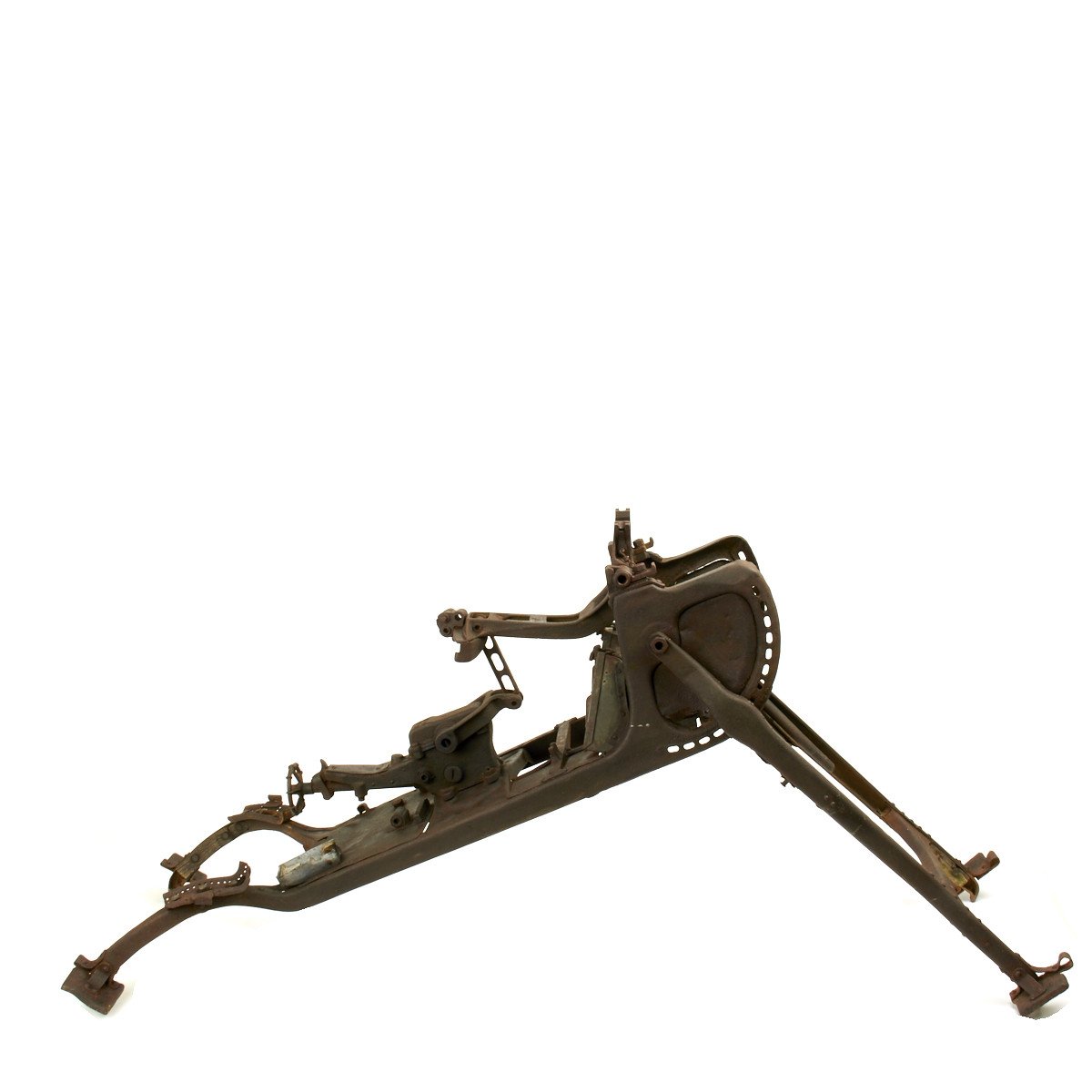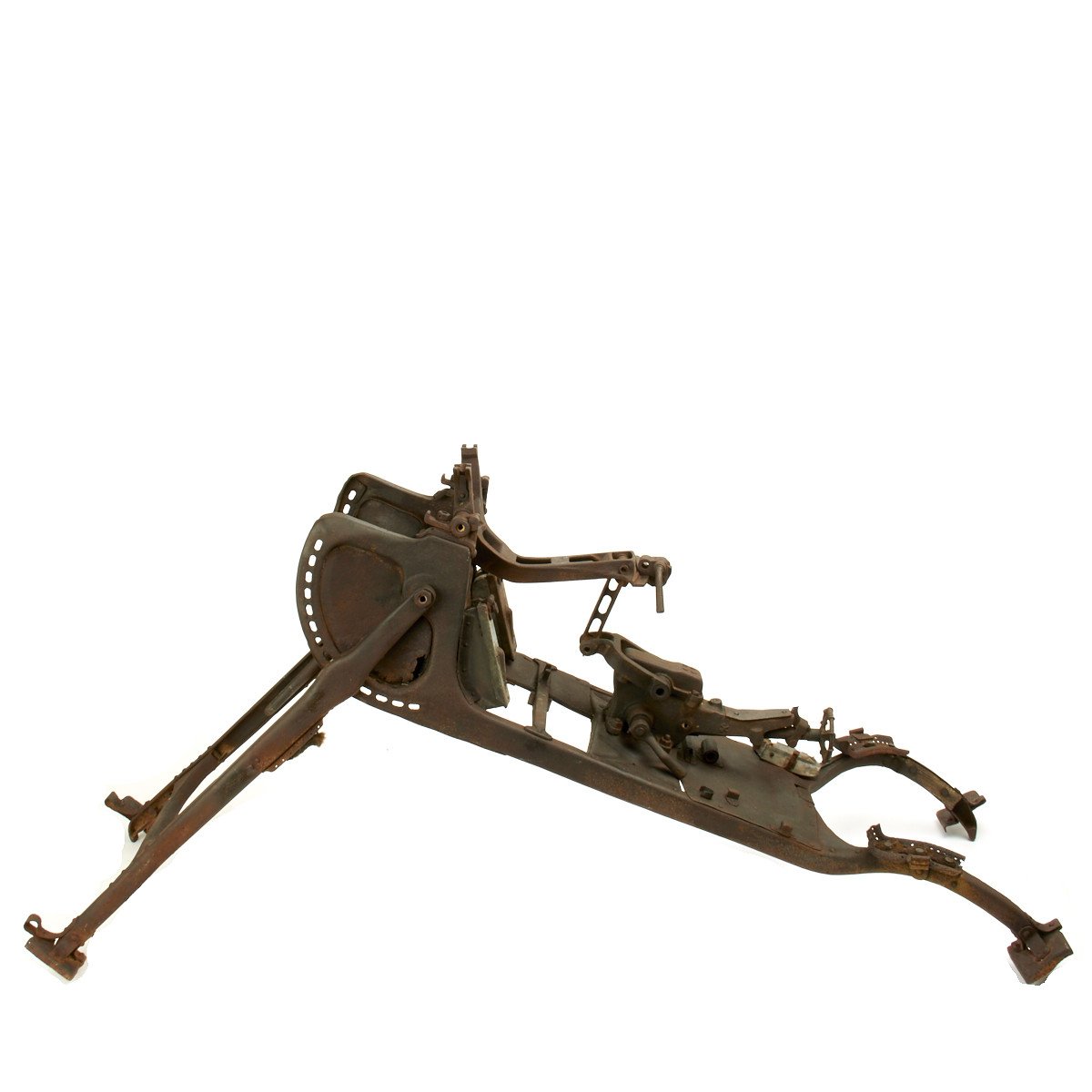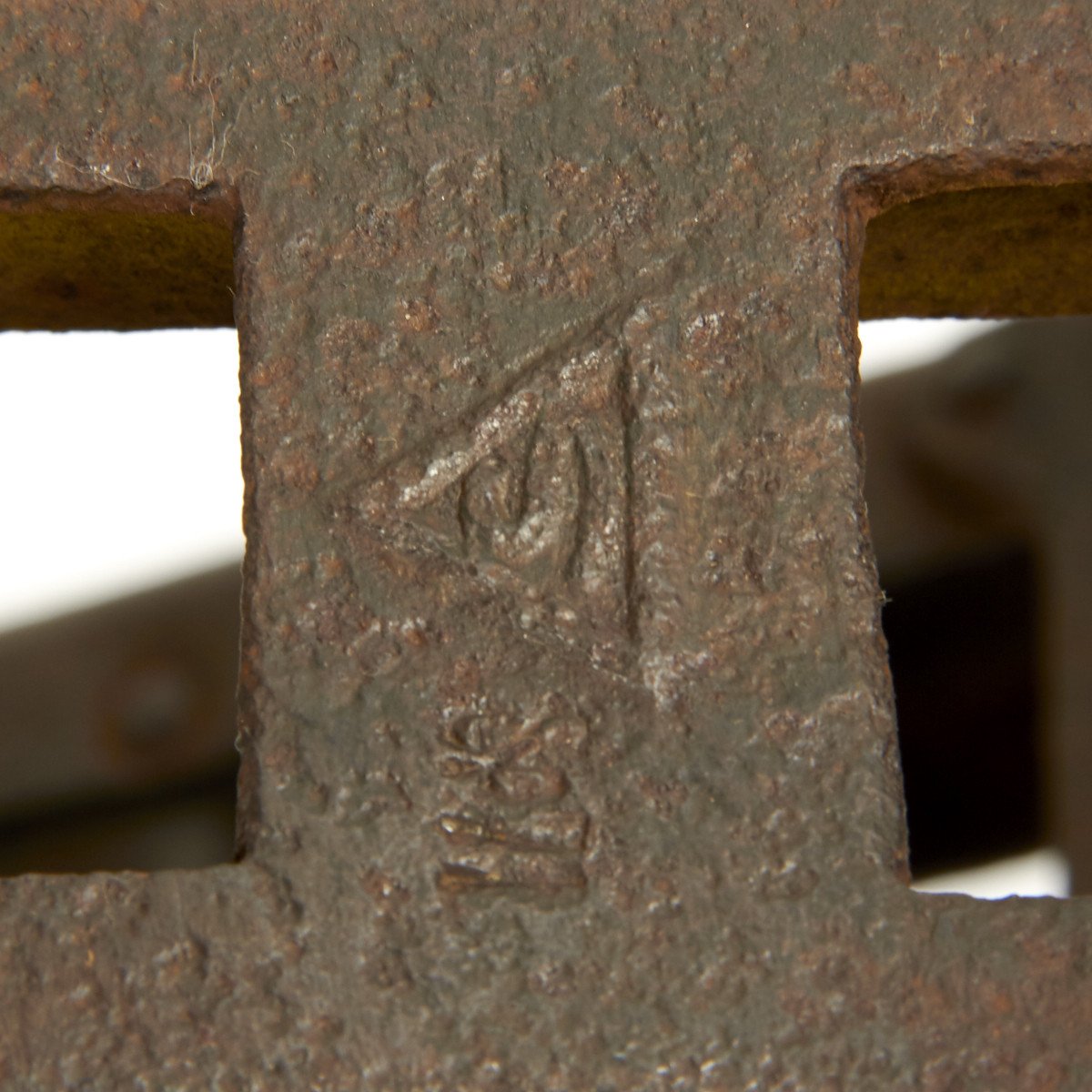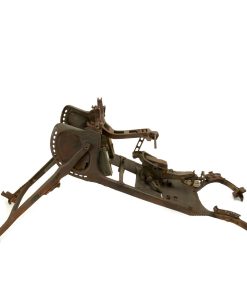German WWI MG 08 Maxim Machine Gun Sled Mount – Serial No 8321 Original Items
$ 4.995,00 $ 1.248,75
Original Item: Only One Available. This is an exceptionally rare sled mount for the German WW1 Maxim MG08 Machine Gun. The MG 08 was usually issued on a sled-type mount of adjustable height (SchlittenLafette08). This mount allowed the gun to be dragged through the battlefield, or to be carried like a stretcher by two or more soldiers. The mount was provided with traverse and elevation mechanisms with rough and fine adjustments.
This mount was a barn find in the southern United States. Luckily it was saved before it was exposed to more moisture and there is surface pitting throughout. However, it is very solid and functional. The all important traverse and elevation mechanisms still work! There are a couple of spots of true rust decay but not in overall important areas. Overall it is decent condition and very restorable.
It is marked 8321 on the upper flat of the right side leg, as well as other markings in multiple locations. The only missing part is the top securing arm, but reproductions of this part are available on the market as it was commonly lost in battle or transit.
Original useable sled mounts like this are exceptionally hard to find, in fact there is one currently on eBay listed for $30,000 USD!!!
Here is your chance to finally have a genuine MG 08 Sled Mount from the Great War to complete your Maxim display.
History of the MG 08:
Germany was one of the first buyers of new machine guns, designed in UK by Sir Hiram Maxim. In 1892, the German company Ludwig Loewe obtained a 7-year manufacturing license from Maxim. Manufacture of German guns commenced in 1894, and in the same year the German Navy adopted the Maxim MG in 7.92x57mm. The license expired in 1899, and at that time a newly established company, Deutshe Waffen und Munitionsfabrik (DWM) began production of the same gun for the German army as the MG99. It was similar to all other Maxim type guns made in the same period,except for the mounting, which was somewhat unusual in appearance.Unlike most mountings, which had three legs, it was a four-leggeds ledge-type mounting, known as Schlittenlafette. This weapon was slightly updated in 1901, when the bronze barrel jacket was replaced by a more economical steel one.
The definitive pattern of the German Maxim appeared in 1908, when the basic weapon was significantly lightened. Known as the MG 08, or more properly, s.M.G. 08 (schweres Maschinen Gewehr heavy machine gun), it was produced by two factories DWM and Koniglishe Gewehr- und Munitions fabrik in Spandau. The latter word was stamped in large letters on the top of the receiver of Spandau-made guns, so it eventually became the nickname of German machine guns (although mostly related to lMG 08/15). These guns were widely used during the Great War (World War 1), and took a heavy toll on Allied forces. After the war, MG 08 machine guns were used by German army until appearance of the more modern guns, such as MG 34.German-made Maxim guns were also widely exported before the WW1, and close copies of MG 08 were built in China during 1930s as Type 24 machine gun.
The MG 08 Maxim machine gun is short recoil operated, water cooled, full automatic only belt-fed machine gun. All Maxim guns fired from closed bolt, which was not a problem for water-cooled guns. Water jackets were made from sheet steel.
The basic toggle-lock action, patented by Hiram Maxim, used two struts, connected by the hinge, and located between the breech block and a barrel extension in such a manner that when breech block was in battery, struts formed a straight line and transferred the pressure, exerted by the hot powder gases through the base of the cartridge, directly to the barrel extension. This caused the entire barrel / extension / breech block group to recoil inside receiver, against the tension of the spring, located under the separate cover outside of the left receiver wall. After short recoil, the cocking handle, which was located on the rear axis of the toggle system, struck the pin installed on the right receiver wall. This caused the cocking handle to rotate up and forward, thus breaking the toggle down. The cocking handle served as both unlocking member and a breech block accelerator, as its shape caused the toggle to open rather fast. During the opening movement of the breech block, the empty cartridge was extracted from the barrel, and the separate breech face, with integral T-slot that held the cartridge case by its rim, was slid down ward, to put the fired cartridge case below the barrel and in alignment with short extraction tube, that was located under the barrel and emerged from the front of receiver. At the same time, the fresh cartridge that was picked by the T-slot during the previous cycle, was lowered and put in line with the chamber. The closing movement of the toggle was controlled by the return spring, located on the left side of the receiver. Unlike most other weapons, the return spring was extended during the recoil, rather than compressed; it was attached to the pivoting lever, located co-axially with cocking handle on the rear toggle axis. Thus, upon counter-recoil cycle, this spring forced the toggle to straighten up from its bent position, pushing the breech block (with fresh cartridge above and fired case below both held in in the T-slot) forward, and entire barrel / breech block system into the battery. Upon final part of closing movement of the bolt, the sliding breech face was risen up, to leave spent cartridge in the ejection tube and to catch the next fresh cartridge from the belt by its rim. If the trigger was still pushed, the firing pin was released by the trigger ling, which engaged the sear, built into the breech block. The trigger itself was located between dual spade grips, at the backplate of receiver; it was pushed by thumbs.
The feed system used non-disintegrating belts, made from cloth or tarpaulin, with metallic struts. Feed was from the right side only; feed system was operated through the horizontally pivoting pin / levers system by recoiling barrel group.
The muzzle booster was of an indigenous design, with a conical flash-hider. Additionally, the muzzle of MG 08 machine guns was often fitted with small circular shield, which protected the front of the thin-walled water jacket (made from sheet steel) from shrapnel, low-velocity bullets and other fragments. The return spring was easily adjustable for tension, with a special scale provided on the spring cover. The receiver backplate was hinged to the receiver.
Prompt Shipping and Professional Packaging
We provide a variety of shipping options due to our long-running partnerships with UPS, FedEx and DHL. Our warehouse personnel are well trained and will pack the goods according to our exact and precise specifications. Before shipping your items will be thoroughly inspected and secured. Every day, we deliver to thousands of customers in different countries. This is a sign of our determination to become the largest online retailer worldwide. Both Europe as well as the USA have warehouses and distribution centers.
Note that orders containing more than one item will be subject to a processing period that is based to the particular item.
Prior to shipping the items, our staff will carry out an exhaustive inspection of the products you ordered. Today, most orders will be delivered within 48 hours. The estimated delivery time is between 3-7 days.
Returns
The stock is constantly changing. It's not entirely managed by us since we are involved with multiple entities, including the factory and our storage. Therefore, the actual inventory could alter at any time. It is possible that you will not receive your order after the order has been made.
The period of time is 30 days. Unfortunately, if 30 days have passed since you purchased your product, we are unable to provide a refund or exchange.
The item must not be in use and must be in the original packaging. The item must be in the original packaging.
Related products
Uncategorized
Uncategorized
Uncategorized
Armoured Fighting Vehicles of the World: AFVs of World War One (Hardcover Book) New Made Items
Uncategorized
Uncategorized
Angolan Rebel 1970s era 60mm Inert Display Mortar from Angolan Civil War Original Items
Uncategorized
Uncategorized
Uncategorized
Uncategorized
Uncategorized
Uncategorized
Uncategorized
Uncategorized
Band of Brothers ORIGINAL GERMAN WWII Le. F.H. 18 10.5cm ARTILLERY PIECE Original Items
Uncategorized
Uncategorized
Uncategorized
Uncategorized
Uncategorized
Uncategorized
